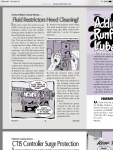Well if the pumps are moving fluid, then at some point in the system the supply is passing fluid to the return and failing to build pressure. The only pressure relief valves are in the pump units themselves and there are check valves after them so I don’t see that as being a problem.
air is not really a problem, it simply is compressed By fluid untill it reaches the workIng pressure and is forced thru the system as a compressed bubble untill it returns to the reservoir It can cause jerking operation until it is purged.
As with nearly all hydraulic troubleshooting you need a pressure gauge. It is to hydraulics, what a voltmeter is to electrical troubleshooting. Disconnect the pressure line from the Air Op Pump and attach a gauge, briefly operate the pump and look for at least 1500 PSI. If it cant do that, the pump is the problem, If it can, cover the fitting and wrench with a rag and release the pressure, re-attach the output line and move the gauge downstream to where it connects to the valve manifold and re-test pressure.
Keep moving downstream. You are looking for the point where you cannot build pressure then you need to figure why it cannot do that.
Always cover the fittings with a rag and keep finders away when loosening/releasing pressure. Hydraulic Skin injection or hydraulic eye injuries are particularly nasty...
you can do this without a gauge because the AOP operates differently loaded or unloaded. With a given input air pressure, Unloaded it goes clunkclunkclunk very quickly. Under load, like with a pipe plug where it’s outlet line should be, it goes cathunk... cathunk... cathunk... much slower as the air must force the piston to build hydraulic pressure...
If the pump can build pressure I suspect you have a crossed line somewhere or the control valve is internally allowing fluid to bypass the work...


